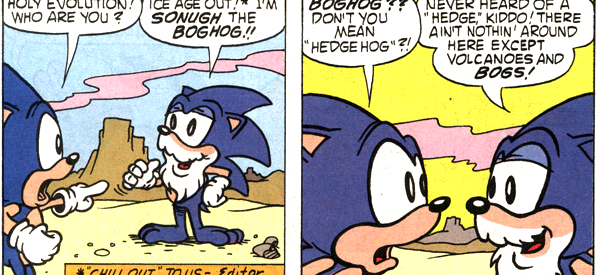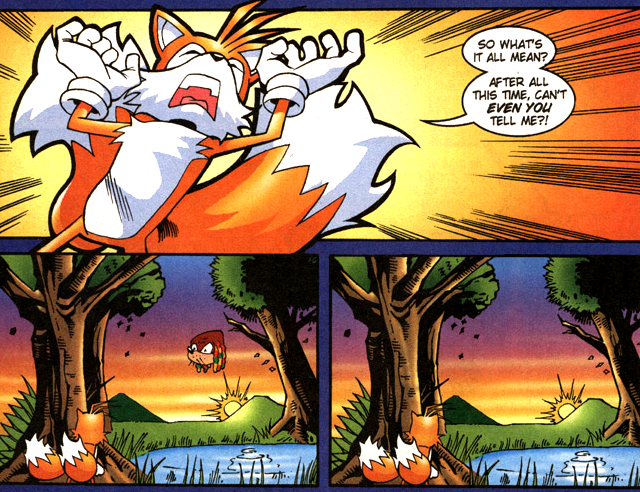
For years now, former Archie Sonic writer Ken Penders has been most well known for his legal battles with Archie and Sega in which he acquired the rights to his characters and stories. Among dedicated Sonic fans, he?s also known for his bad tweets and strange art style.
You know what doesn?t come up as often? The actual content of his stories.
Sure, everyone vaguely knows the Archie comics are weird, and it?s easy to find goofy out-of-context panels. But that?s only skimming the surface. What?s up with the bizarre recurring themes in his stories? The obsession with asshole dads? The weird attempts at mature themes? Dingo firing squads executing civilians? A cartoon bee dying from eating an LSD-laced chili dog? Distasteful allusions to the Holocaust? Implications that teenage Sonic characters were having sex off-screen? Why did any of this happen?
Few can answer this, because few want to analyze over 100 issues of mediocre furry soap opera comics with bad politics. I mean, there?s no shortage of good Sonic comics you could read instead. Who would be stupid enough to do that?
Me. My name is Bobby Schroeder, and I?m stupid enough.
Five years ago, I started a blog to archive my journey through Archie Sonic. I jokingly gave it the name ?Thanks, Ken Penders.? Now, in 2019, I?ve finally finished reading every issue the man ever wrote for Sonic the Hedgehog and its spinoffs. To close out this first leg of my journey, I?d like to take some time to summarize what the fuck is up with Ken Penders? bizarre Sonic comics.
I expected them to be weird. I did not expect them to be this weird.
So? compared to the other writers on the series, what did Penders actually bring to the table with Archie Sonic?
Continuity and lore
The earliest Archie Sonic issues were written primarily by Michael Gallagher (who also did a lot of weird and distasteful shit, but that?s another post), and they focused almost exclusively on gags, puns, and fourth wall breaks. Due to the source material, the comics also occasionally had a slight satirical edge when it came to environmental issues.
It was entertaining enough, and a lot of fans look back on those comics fondly. But there wasn?t much to sink your teeth into if you preferred the more serious tone of the Saturday morning Sonic cartoon (SatAM) that inspired the comics in the first place. I mean, this was a story about an evil dictator (Robotnik) taking over the world and turning the populace into robot slaves, leaving a small band of teenage rebels (Sonic, Sally, and the other Freedom Fighters) to stop him. But most of the early comics were like this:
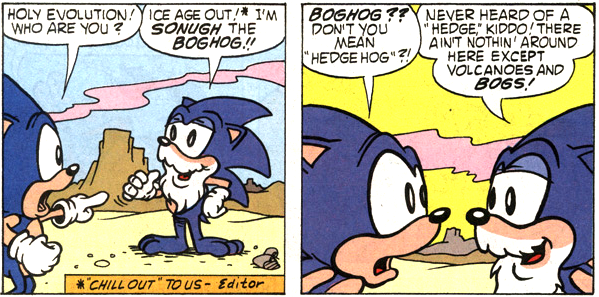 would you be surprised if I told you Sonugh the Boghog never comes back
would you be surprised if I told you Sonugh the Boghog never comes back
This all started to change with Sonic #11, when writer (and later penciler, inker, colorist, letterer, etc.) Ken Penders came on board with temporary creative partner Mike Kanterovich. While they tried to tell sillier Gallagher-style stories at first with mixed results (they actually almost did a Mario parody), it didn?t take long for Penders to shift towards a more serious, serialized structure.
This style was most clearly on display in the 32-issue Knuckles the Echidna series, which ran from 1997 to 1999 and was written exclusively by Penders. The Knuckles comics were very much one long story broken up into smaller three-issue arcs. In a time when Sonic was handled by many different writers and artists (and therefore varied wildly in quality and style), Knuckles was incredibly consistent. If you liked the series, you knew what you were getting into every month, and it was all apparently building towards? something.
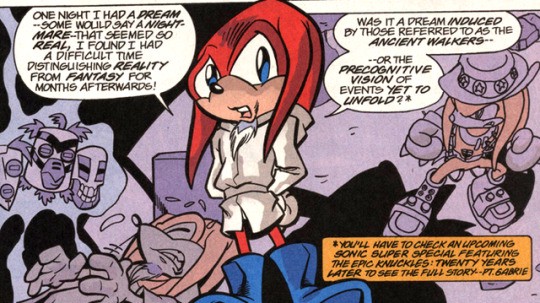
Premonitions of a troubled future promised readers that Knuckles and co. were destined to save the world from a major threat in their adult years, and that the audience?s patience and dedication would be rewarded. Many readers stuck with it month after month, wanting to see what Ken had been building towards. But in hindsight, many of his most hyped ideas (the Chaos Knuckles arc, ?Mobius: 25 Years Later?) ended up being total duds that massively disappointed a lot of longtime readers.
These days, most fans don?t seem to think Penders? eventual payoff, whatever he had in mind, would?ve been worth it. In retrospect, most of his stories feel more like teases for future issues than engaging narratives in their own right. But he still has a small but loyal following of people who are dying to see him finish his take on the story. Penders is more than happy to egg them on, saying that he considers all of his successor Ian Flynn?s stories non-canon and that the real ending will come in the form of the The Lara-Su Chronicles? you know, if that?s ever released.
Countless original characters
?Who the hell is Lara-Su?? you may be asking. Penders is known for introducing a great many new characters to the comics. This is either a good thing or a bad thing, depending on who you ask.
While many of the characters added in licensed Sonic media are fan favorites (the Freedom Fighters, Cosmo, Tangle, Whisper, etc.), Penders? additions to the Archie cast were a mixed bag. Some of them, like Knuckles? love interest Julie-Su or Sally?s brother Elias, showed a lot of potential, and still have a lot of fans to this day. But it always felt like Penders mistook quantity for quality.
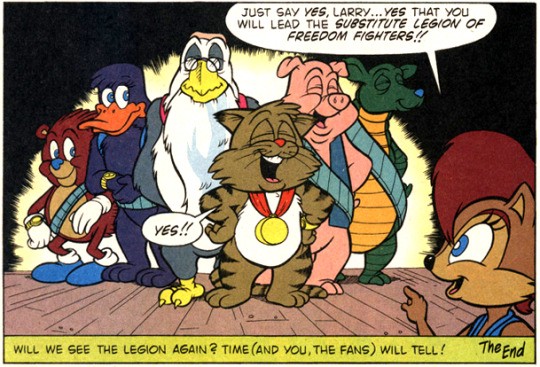 Pictured: Sally, and six characters whose names you probably don?t know.
Pictured: Sally, and six characters whose names you probably don?t know.
The Sonic wiki lists nearly 200 characters introduced by Ken, and a lot of them aren?t names you would recognize. You have your forgettable but inoffensive characters like Penelope Platypus or Valdez the Chameleon (who is not Espio in a hat). Then you have about 7.5 trillion echidnas, most of whom look extremely similar to Knuckles. And then you?ve got the downright bizarre characters, like Charmy?s butler Jeepers the bee, who looks like an absolutely wasted John Adams cosplayer. (Side note: Penders made Charmy a prince.) Oh, and who could forget the traitorous Sleuth ?Doggy? Dawg? Or how about a human poacher very blatantly inspired by ?The Most Dangerous Game,? who was named? Hunter?
Again, the key word is ?potential.? Penders is a writer who has okay ideas, but tends to stumble on the execution. In the hands of other writers, his characters can turn into something really special. The ?Return to Angel Island? arc (#138 ? #141) was basically just writer Karl Bollers giving us a fresh take on the Knuckles comics, and it was fantastic. And prior to the 2013 continuity reboot (which was sparked by Archie losing their lawsuit against Ken), many of Ian Flynn?s comics revolved around breathing new life into Ken?s old ideas.
Of course, Ken?s vision for Sonic is? unique.
A general lack of interest in Sonic
Almost everyone who works on the Sonic comics these days grew up as a fan. These folks really care about these characters (even the ?uncool? ones like Cream the Rabbit or Silver the Hedgehog), and it?s clearly a labor of love. For a troubled franchise like Sonic, this is something truly special.
But this obviously wasn?t possible in 1993, when the kids who grew up with the Genesis were still? you know, kids. So instead, they got a ragtag group of creatives who were available at the time, such as Michael Gallagher and Dave Manak, the creative duo behind Marvel?s Alf comics. Why not? Sonic and Alf are basically the same character, right?

Penders ended up working on Sonic by mere happenstance. It was a gig that was hiring, and he happened to know a guy. But because Penders was the first writer at Archie to really give a shit about lore, he got to steer things in a direction he personally preferred. Now, there?s nothing wrong with bringing in outside influences (as I write this, IDW?s Sonic is trying to stop a zombie apocalypse), but Ken?s tastes are very? narrow. Star Trek, the works of Jack Kirby, Dungeons & Dragons. That sort of thing. He?s very much your typical nerdy baby boomer. So in the ?90s and early 2000s, you had this hip and trendy video game franchise for kids known for its use of pop, rock, and rap music, and the comic adaptation read like a bizarre Silver Age comic or a D&D campaign. (For a fun bit of tonal dissonance, try listening to this classic Sonic CD track while reading those panels with the sword horse.)
The perfect example of how odd Ken?s vision was for Sonic? He wanted to make Sonic?s birth name Olgilvie Maurice Hedgehog.
Why not stick closer to the content of the games? Well, in the ?90s, there were only a handful of Sonic games, and they didn?t exactly have a ton of story content to build off of. But also? Penders didn?t play the Sonic games. He?s been very open about this fact online. He sees Sonic as a comic character first and foremost. When Sega?s vision clashed with his own, he tended to ignore it the best he could. (For that matter, he also didn?t read the other writers? stories.)
One of the most infamous side effects of this unfamiliarity with the games is seen in the ?Sonic Live? special. In it, Ken?s actual son and niece are sucked into the TV to go on an adventure with Sonic. (They don?t really end up helping, and Sonic almost gets them killed along the way.) In the live action opening, which was shot by Ken himself, they?re supposed to be playing an unspecified Sonic game? except I guess Ken didn?t own any Sega consoles. So instead, he just had his son hold his TV?s remote sideways while looking at a blank screen.
 I?m pretty sure he just hit the power button
I?m pretty sure he just hit the power button
In an effort to move the comics into new territory, Penders also tried to kill off Robotnik. Multiple times! He wanted to replace him with his own original villains like the Dark Legion and Dr. Droid (who? basically served the same purpose), but this never worked out for obvious reasons.
He actually did kill Robotnik, though! This happened in Sonic #50, at the climax of the ?Endgame? arc. This was envisioned as potentially being the series finale, so Robotnik dying would?ve made sense? but then the comics kept going. Ken was very stubborn, though, and he hated other writers undoing his stories with a passion. So they couldn?t bring back the original Robotnik. Instead, around Sonic #75 (shortly before the adaptation of Sonic Adventure), Karl Bollers brought in an alternate universe counterpart (?Robo-Robotnik?) who Penders had previously introduced. This incarnation ended up sticking around for the rest of the series, while the Robotnik of the first 50 issues (mostly) stayed dead. Because of this, the classic Robotnik and the modern Eggman are technically two separate characters in the Archie comics.
(Side note: That new villain Penders wanted to introduce, Dr. Ian Droid? He was introduced in a crossover between Sonic and several extremely adult-oriented Image Comics properties like Spawn and Savage Dragon. Penders also used this special as a backdoor pilot for his own Image series, The Lost Ones, which lasted one issue.)
You know what he disliked even more than writing Robotnik, though? Writing teenagers! Which is kind of a problem in a series about teenagers. We had story after story about how Sonic and co. should listen to their elders, and how they?ll grow up someday and have rebellious kids of their own who they won?t understand. We had characters talking down to Sonic for being a teenager, even though the games and most other Sonic media tended not to draw much attention to his age. And most of Ken?s pet characters were adults. Knuckles? dad. Sally?s dad. Geoffrey St. John. Hershey the Cat. Dr. Quack. Harry the cab driver. The preference was obvious.
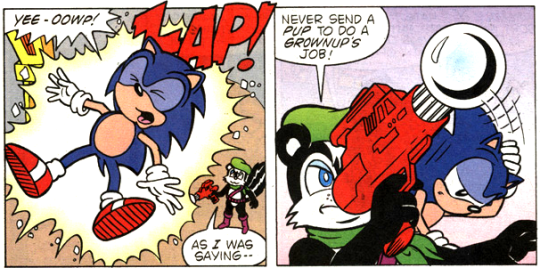
There was one exception, though. Knuckles.
As time went on, Penders made Knuckles more and more important. Knuckles became the hero of his own stories, and then a chosen one of prophecy, destined to save the world ? no, the entire multiverse. Knuckles wasn?t just Sonic?s friendly rival and the guy who guarded the Master Emerald, he was Mobius?s greatest hero. Knuckles slowly unlocked more and more Chaos Emerald powers over Ken?s run, culminating in his green Chaos Knuckles form in which he literally had the power of a god. He could reshape reality at his whims and do anything he could think of, and he stayed in this form for over two years. (Not that Knuckles accomplished much of anything in this time.)
As the ultimate statement of Knuckles? importance over everyone else, when Penders explained how Robotnik had finally been defeated in ?Mobius: 25 Years Later?? Knuckles was the one who had killed him.
So what was up with this guy?s fascination with Knuckles?
Echidnas, echidnas, echidnas

There are a few factors that led to the proliferation of echidnas in Ken?s comics, but it?s mostly a matter of coincidence. For one, Knuckles instantly became a fan favorite, so Archie naturally wanted more stories about him. Ken?s desire to make his mark on the lore of Angel Island and the echidna race meant that it didn?t take long for Archie to give him near complete control over the character in their comics. Sega apparently also let him do basically whatever he wanted with Knuckles, whereas pitches for Sonic-centric stories faced much more scrutiny, so it didn?t take long for Ken to start dumping all of his ideas into Knuckles stories.
Really, with little established canon to worry about at the time, Angel Island was just this perfect little isolated part of the world where Penders could tell his own original story that, deep down, had little to do with the Sonic franchise.
To kick things off, Penders established that Knuckles was guarding Angel Island because he was the latest member of the Brotherhood of Guardians, a role passed down from father to son for generations. (Knuckles had exactly one female ancestor who served as Guardian, but we barely ever saw her, because of course we didn?t.)
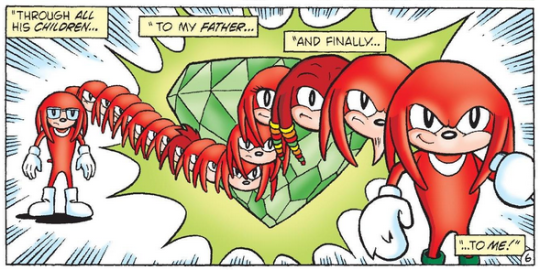 Knuckles is the latest Knuckles in a long line of Knuckleses
Knuckles is the latest Knuckles in a long line of Knuckleses
Penders? Knuckles is not the lovable blockhead with a quick temper from the games and other media. He?s more of a generic comic book leading man. He?s smart and uses lots of big words, but he?s not quite a genius. He has quips and one-liners, but he?s not really funny. When he got his own series, he briefly tried to use ?It?s crunch time!? as a catchphrase. This didn?t catch on. Ultimately, he sounds like most other characters Ken writes. He has few defining traits, and the story just sort of happens around him.
After a string of stories where Knuckles wandered around Angel Island and talked to himself, and then two arcs about him actually fighting bad guys, Penders made another big reveal. The high-tech capital city of Echidnaopolis, which Knuckles believed had been destroyed hundreds of years ago, still existed. The city quickly became the new primary setting for the Knuckles solo series.
At this point, the floodgates were truly open
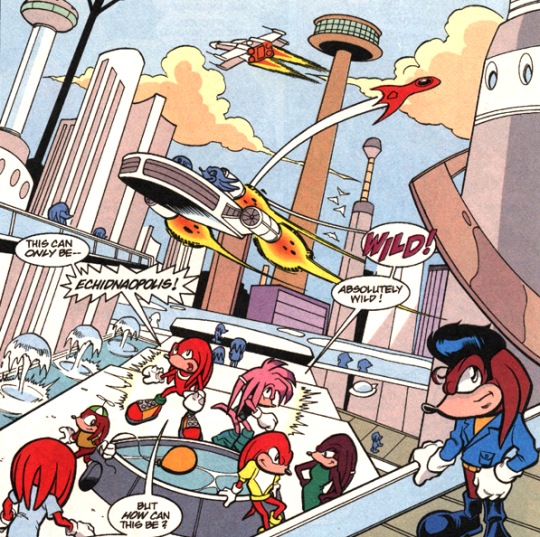
It took me a while to realize this, but Penders sort of turned the echidnas into Kryptonians. (In hindsight, the hyphenated female echidna names like Julie-Su and Lien-Da were dead giveaways.) Our superpowered hero, the son of an incredibly important scientist with a god complex, was originally thought to be the last survivor of this highly advanced race. But eventually, more survivors were found, and soon there were important echidnas all over the place. They?re even associated with magic green crystals! And to really drive this similarity home: for years, Penders wanted to tell a story where Mobius exploded and everyone fled to space.
Penders also had a tendency to treat echidnas as very special. When explaining Mobius?s prehistory, he established them as the first race to attain advanced technology after the apocalypse. (Oh yeah, have I mentioned that Mobius is a post-apocalyptic Earth in the Archie comics? That wasn?t Ken?s idea, though.) Because of this, the echidnas have always thought they were better than everyone else. They?re supposed to be key allies of Sally?s royal family, but they repeatedly refused to help in the war against Robotnik because they?re smug, isolationist assholes.
Knuckles? ancestors were also horrible British colonizers ? the echidna homeland is in Mobius?s version of England ? who took land from the ?less evolved? races (ugh). This includes the dingoes, natives of Downunda (Mobius?s Australia) whose land was stolen so that Echidnaopolis could be built. And when I say the land was ?stolen,? I mean that quite literally ? the echidnas eventually hoisted it into the sky to dodge a meteor, creating Angel Island as we know it. They basically Brexited their capital city into the goddamn sky. Needless to say, the dingoes were not pleased about being stuck on a big floating rock with their oppressors.
On that note, I should probably talk about the furry politics in these comics, huh

Immature attempts at maturity
Many of the strangest things that occurred in Ken?s run were misguided attempts at making his stories come off as more ?mature,? which catapulted the tone of the comics straight from the Silver Age into the Dark Age. This came in many different forms.
1. Furry politics!
Penders often injected allusions to real world politics into his comics. Now, to be clear: I am absolutely not a ?keep your politics out of my comics? type. The problem is Ken isn?t self-aware enough to treat these topics with care.
There are too many examples to list all of them here. The brief attempt to write an oppression allegory around the roboticized Mobians. Rotor?s sudden staunch anti-gun stance and his claim that the Freedom Fighters had never used guns, even though Penders had given Rotor guns multiple times before. (Note: I?m very pro-gun control myself, Rotor was just written inconsistently.) But probably the biggest example is the obsession with fascism in the Knuckles comics. Granted, Penders had nothing to say about fascism, other than ?it?s bad.? But boy, for someone with nothing to say on this topic, Penders sure did say a lot.
The Dark Legion, the main bad guys of the Knuckles comics, are techno-fascist echidnas. The comics really beat you over the head with this fact. One Knuckles arc focused on them rigging an election, and it included an absolutely bewildering number of tasteless allusions to World War II and the Holocaust. This included echidnas doing ?hail Hitler? salutes, Legionnaires smashing windows to evoke Kristallnacht, and most infamously of all? Penders rephrasing Martin Niemller?s ?First they came?? to be about echidnas and hedgehogs.
I wish I was kidding.
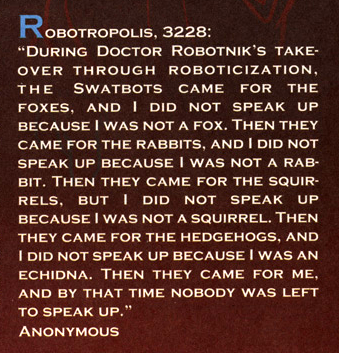 that isn?t even how it happened
that isn?t even how it happened
So yes, the Dark Legion are a bunch of Nazis, and their leader Dimitri is Echidna Hitler. But Dimitri is also Knuckles? great great great great (like fifteen more greats) uncle from the past. Eventually, Knuckles teams up with Dimtri, in order to save Echidnaopolis from? Dimitri? Yeah, it didn?t make a lot of sense. But then, after this point, Knuckles inexplicably started sticking up for Dimitri and the Dark Legion? And telling everyone to trust them?
Knuckles literally pretends to take a bullet to convince the other echidnas to trust the Legion, even though only a dozen or so issues prior Penders was writing them as in-your-face Nazi allegories.
To make matters worse, though, the Dark Legion aren?t the only Knuckles villains who were designed to evoke Nazi Germany. There?s also the dingoes! ?Wait Bobby,? I can hear you saying. ?You just said that the dingoes were a native race that the echidnas colonized and subjugated.? Uh huh! Are you seeing the problem here? On the one hand, the dingoes are a marginalized racial minority who got stuck on a floating island with their colonizers ? they literally live in Echidnaopolis?s ghetto, and they?re shown protesting for equal rights a few times. At the same time, these same dingoes are also a bunch of Nazis with buzz cuts and jodhpurs and names like ?Helmut von Stryker.? Ken wanted to have it both ways. Eventually, Knuckles starts to sympathize a bit with the dingoes, but their methods are always framed as too violent, and Ken avoided depicting any women or children among the dingoes so that they?d come off as less sympathetic.
Okay, let?s back up. Why are there techno-fascists? Well, one of the central storylines in Knuckles is an ideological battle over the use of technology.
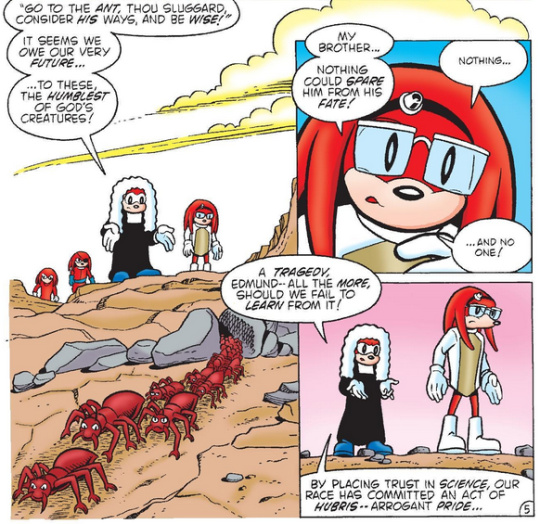
Early stories repeatedly claimed that the technology-reliant echidnas of the past (in particular Dimitri, future Echidna Hitler) were punished for their hubris. To repent, they apparently abandoned their technology and destroyed the city of Echidnaopolis. As it turns out, that last part isn?t true in the slightest. The city and its tech still exist in Knuckles? time. Okay, but surely they got rid of their weapons, right? Nope! They still have guns!! Hell, at a later point, Sally goes to the Brotherhood for help in the escalating fight against Robotnik, and they refuse because the Freedom Fighters won?t use their guns. They just love guns so goddamn much, you guys.
They also had nukes!
Confusingly, the Dark Legion (the bad guys in the Knuckles comics) started out as a faction that wanted to maintain the status quo and prevent the rest of Echidnaopolis from abandoning technology. But like I said: the good guys never abandoned their technology. The status quo never actually changed much. So what exactly did the Legion want? Who knows! They just arbitrarily turned into cyborg fascists and got exiled.
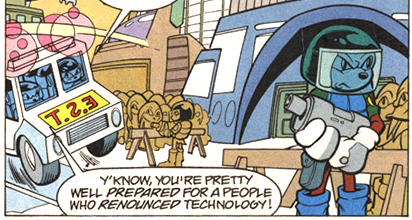
This theme of an ideological battle over technology never really goes anywhere. For a time, it seems like the hypocrisy of the Brotherhood and the Echidnaopolis government is intentional. The High Councilor (basically the mayor) is really bougie, and attention is drawn to his personal limo. There are technological haves and have-nots in this society, and those in power get to decide who?s who. But this train of thought also fizzles out, as Knuckles? family is just as rich and bougie as the High Councilor, and this is never painted as a bad thing. Later, Penders tries to reframe the whole conflict as one of religious fundamentalism vs. reckless technological progress (even though the radical pro-tech guys, the Dark Legion, initially only wanted to preserve the status quo). In this framing, Knuckles sort of represents a balance between the two sides as both God?s chosen one and a genetically engineered bioweapon.
Have I mentioned that Knuckles is a genetically engineered bioweapon?
2. Drugs!
Knuckles #13 opens with Harry the dingo cab driver (the one dingo character who isn?t a Nazi) discovering Charmy Bee in an alley, with another bee we?ve never met before collapsed in his arms. Harry rushes Charmy and his apparent best friend Mello to the hospital. The doctors try their best, but they have to break the bad news to Charmy. Mello is dead.
How did Charmy?s best friend die? Oh, by accidentally eating a drug-laced chili dog and overdosing on LSD!

See, the shady owner of the local carnival is secretly working with a drug lord. He?s lacing his carnival food with this substance called ?Lemon Sundrop Dandelion? (very subtle, Ken) in an effort to get the locals hooked on it. And now kids are getting poisoned left and right, including Charmy?s friend. The Chaotix investigate, but they get hungry and idiotically decide to eat the carnival food, and well?
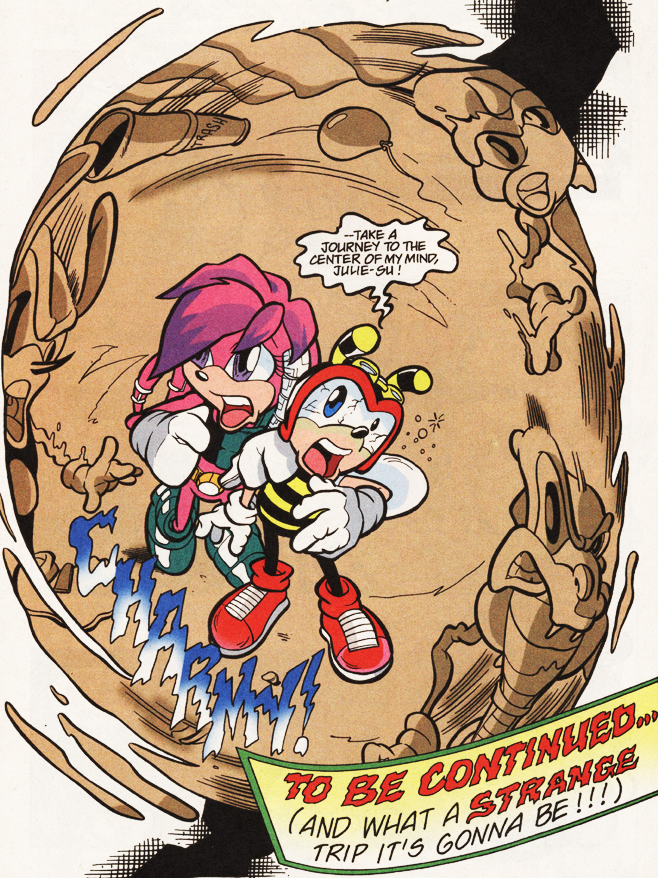
Then they get dragged to the hospital because they?re fucking tripping balls on acid. Shenanigans ensue
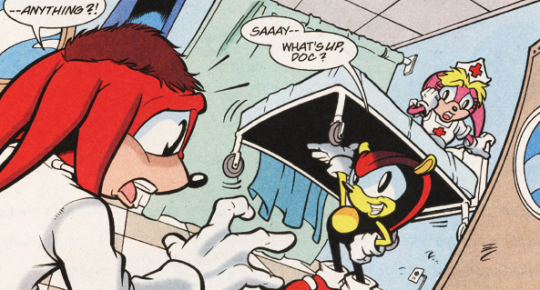
Yes, this happened in an officially licensed Sonic the Hedgehog comic.
This is the only story about drugs in the series, but it?s so bizarre because it doesn?t focus on the usual Very Special Episode peer pressure narrative. The victims don?t even know they?re being drugged! It reminds me more of those nutty articles claiming people are giving away edibles to trick-or-treaters.
3. Religious allegories!
Since he made Knuckles a chosen one, Ken just couldn?t resist throwing in some Christ allusions. Early in his solo series, Knuckles is vaporized by Dimitri, then resurrected by the Ancient Walkers (three of the deities of Mobius) to become the savior of echidna kind. Later, he makes a heroic sacrifice (this time to save Dimitri, the guy who killed him last time) and is resurrected by another deity. In one issue, Knuckles? mom is praying in an echidna church, bathed in holy light, and then comes home to suddenly find Knuckles, seemingly answering her prayers. And of course, the most classic example: a scene where Knuckles led a bunch of other echidnas to the promised land by literally walking on water.
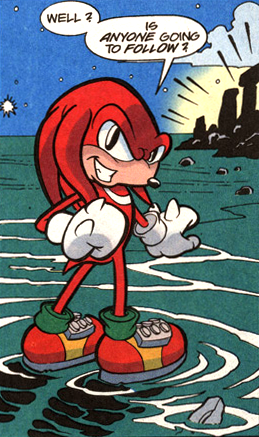
Of course, while Knuckles is Echidna Jesus, there?s also his father, a bearded man who watches over everything he does from afar and judges his every action. I was so mad when I figured this one out. But everything about Locke makes me mad, really.

Bad dads
Penders had a love of introducing secret family members. Sally had a long lost brother, Elias, who everyone had conveniently forgotten about. Sonic had his parents, Jules and Bernie (the latter of whom is named for Penders? wife), who had gone missing during Robotnik?s takeover. But two family members have always loomed large over Penders? stories. Those characters are Sally?s father, King Maximillian Acorn, and Knuckles? father, Locke.
To explain Locke and his whole deal, I have to talk about the Brotherhood of Guardians. You know how I said that Knuckles was the descendant of the previous Guardians of Angel Island? You probably assumed that meant the previous Guardians were gone, right? Nope! Knuckles has grandpas who are still alive like eight generations back. Possibly more ? most of them are interchangeable, so it?s easy to lose count. They refuse to die for hundreds of years because of Chaos Emerald magic. On the rare occasions one of Knuckles? racist grandpas managed to actually kick the bucket, I was ecstatic.
This secret cabal of racist grandpas has almost complete control over Angel Island. They?re essentially royalty. They still let Echidnaopolis act like a democracy, but the Brotherhood rules from the shadows, operating above the law however they see fit with no one to hold them accountable. This is never presented as a bad thing. So yeah, all of the previous Guardians were assholes. But Locke is a very special breed of monster.
One night, before Knuckles was born, the echidna God showed Locke a vision of his adult son battling a giant robot. Locke was so spooked by this that he decided he had to perform dangerous genetic experiments on himself to turn his offspring into a mutant superweapon. After his wife, Lara-Le, laid Knuckles? egg (they?re echidnas, remember), Locke took the egg and blasted his unhatched son with dangerous Chaos Emerald radiation in the hopes that it would give him superpowers.
This whole backstory is lovingly summarized by fans as ?had a bad dream, better microwave the baby.? This story is also why Knuckles has mutant knuckles.
 Pictured: Locke, microwaving the baby.
Pictured: Locke, microwaving the baby.
It gets worse, though! See, Locke did all of this without telling his wife. She was completely left out of this decision making process. Then, when Knuckles was an infant, Locke decided that he was going to take him to live in the wilderness and train to be the next Guardian. Again, Knuckles? mother Lara-Le had no say in this, and was visibly distraught over having her infant son taken from her.
Out in the wilderness, Locke trained and home schooled Knuckles, but he also told his son all sorts of lies. He lied about Echidnaopolis being destroyed, and told Knuckles that the two of them were the last of their kind. He let him believe that his mother was dead. And then, at the age of 10, Locke abandoned Knuckles. He jumped into a wall of fire and convinced Knuckles that he had killed himself, leaving the 10-year-old Knuckles as the sole protector of Angel Island.
In reality, the fire was merely a hologram. Locke watched over Knuckles through his network of spy cameras and continued to control his life from the shadows, but his son believed he was alone. At one point, Locke and the Brotherhood also tried to murder another kid who was picking on Knuckles. They literally threw a gorilla off of Angel Island in the middle of the night.
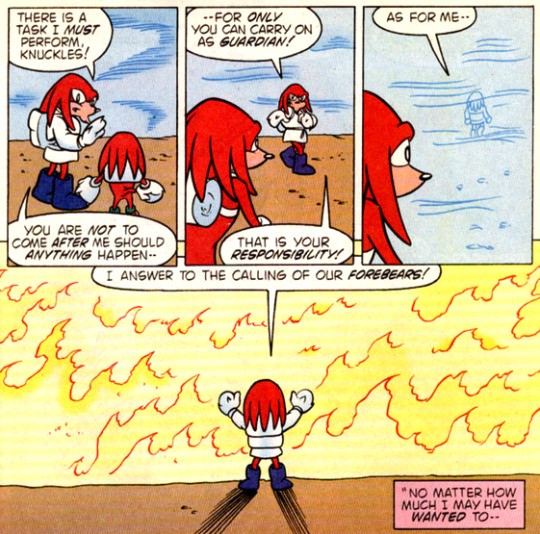
Fast forward to the early issues of Knuckles, and the titular hero has been monitored by his ?dead? father nonstop for several years. Knuckles starts to meet other relatives he thought were dead, like his mom and a few of his racist grandpas (all of whom know that Locke is still alive), but Locke remains out of sight. Knuckles grows increasingly frustrated with his family?s secrecy and the pressure put on him, and it looks like his destiny might be to confront the Brotherhood and break from their horrible traditions.
If you?re unfamiliar with the series, you?re probably reading all this and thinking ?so Locke is a villain, right??
Nope!
We hit Knuckles #25, and Penders decides it?s time for Knuckles and Locke to reunite because it?s a milestone issue. How does this happen? Knuckles spots Locke in the city completely on accident, and Locke doesn?t manage to get away fast enough. So he just? gives up, and lets his son catch him.
Does Knuckles confront his dad for all the lying and manipulating? Is he mad when he realizes his dad faked his own death? Does Locke apologize for anything? Nah!!! Knuckles is just happy to see him! Even after Locke explains that he used Knuckles as a guinea pig and forced him into the role of a savior from birth because he had a vision one time, Knuckles seems cool with it. He immediately forgives his dad for everything, starts pretending they have a normal father-son relationship, and never questions him again. Years in the future, Knuckles reflects on how good of a parent he thinks Locke was.
Locke never has to pay for what he did. The fact that he meant well is good enough. We?re supposed to like him. Ken sure did! Hell, we?re even supposed to think he?s cool! Towards the end of his run, Ken did baffling things like having Locke beat Shadow in a fight and having him get kissed by Rouge the Bat. Rouge was just using him to get the Master Emerald, but she still seemed to think he was the hottest stud on Angel Island. (Penders allegedly did not know that Rouge was only 18 when he wrote this arc.)
Locke never apologizes to Knuckles, or his ex-wife for that matter. Oh, and speaking of her, there?s also this absolutely dreadful part where Locke forces a kiss on Lara-Le, even though they?ve been divorced for years and she?s engaged to someone else. This even immediately follows a flashback to Locke being horrible to Lara-Le in the past. It is putrid.
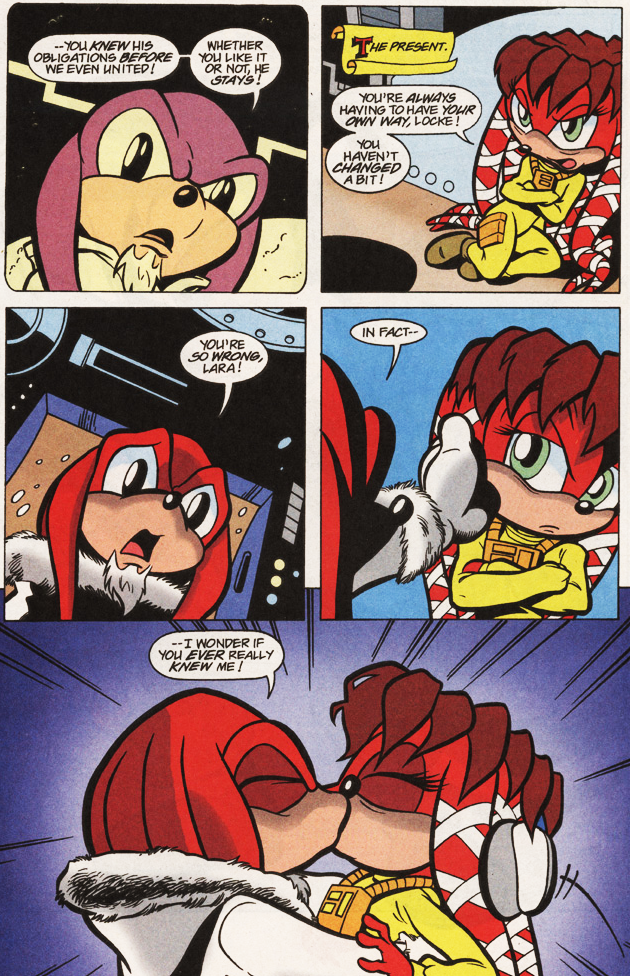
Locke wasn?t alone in this, either! Under Penders, Sally?s father, King Maximilian Acorn (who we?ll discuss in a moment), was just as bad. And in his final arc before quitting, he almost turned Sonic?s Uncle Chuck into another father figure who fucked up catastrophically but ?meant well.?
I don?t personally like to psychoanalyze Penders through his stories ? at the end of the day, I don?t know the man, no matter how many comics of his I?ve read ? but with the topic of shitty dads, it?s hard not to.
See, Penders has been very open about the fact that Locke was based in part on his own father. As Ken has explained, he had a rough relationship with his dad, and only really made amends with him at the end of his life. A flash forward story about Knuckles mourning his father?s death (the cause of which was pancreatic cancer, a side effect of Locke?s experimentation on himself) was dedicated to Ken?s own father. And you know, on some level, I sympathize with the guy. Growing up with a shitty dad is tough, and leaves you with a lot of baggage and complex feelings after he?s gone.
The problem is that the feelings characters like Knuckles and Sally have about their awful abusive dads aren?t complex. On the contrary, they?re incredibly black and white. They?re frustrated with their dads at first, but they always have ?good reasons? (usually ?God showed me the future?) for the horrible things they do. After the shitty dads explain their reasoning, their kids forgive them unconditionally. In their eyes, the behavior was justified by the fact that their dads ?had their best interests in mind.? Father knows best, after all!
This recurring theme is honestly one of the most sickening parts of Ken?s body of work to me. The message it sends to kids is loud and clear: ?you must love your parents unconditionally ? they only hurt you because they love you.?
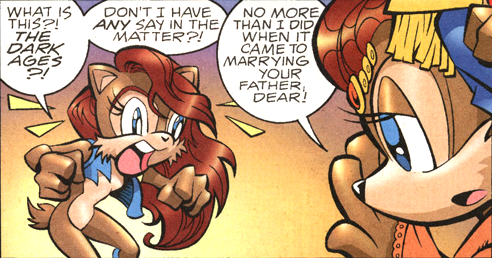
Sally had a bad dad, too
The earliest comics did not treat Sally Acorn well. Where SatAM?s Sally was a bold, confident leader with a sharp wit, writer Michael Gallagher?s Sally was Sonic?s nagging girlfriend who tended to either stay home or get kidnapped. Even in issues where she wasn?t kidnapped, they?d often depict her as a damsel on the covers. And where cartoon Sally downplayed her own status as royalty, comic Sally liked to sit on a big throne and boss everyone around.
Things actually started to improve with Ken?s early work. One of his first stories was a patronizing but well-meaning ?girls can do anything? story starring Sally and Bunnie Rabbot, and he quickly took an interest in fleshing out Sally?s backstory. The first sign that this wouldn?t last, though, was the three-issue Princess Sally miniseries. In it, Sally finally got to go on a big adventure of her own. Except? not really. Much of the spotlight was hogged by Ken?s new character, Geoffrey St. John (oh boy, we?ll get to him), and the Sally we followed for over half of the story? Was actually a robot doppelganger. Yes, for the sake of a twist, the Princess Sally miniseries did not actually star Princess Sally. Even ignoring this, Sally came off as flat. She was too perfect, with no real personality. Ken tried so hard to write a ?strong female character? that he wrote one with no interesting traits whatsoever.
This miniseries sold poorly (it was mostly marketed towards boys, who were afraid to buy a ?girly? comic). Ken took it as a sign that fans didn?t like Sally.
A couple years later, the Freedom Fighters finally succeeded in their quest to save Sally?s father, King Maximilian Acorn, who had been missing for ten years. This felt like a huge victory. The tide was beginning to turn in their favor. But to Penders and the other writers, the King being back meant the Princess was no longer needed. The writers didn?t really know what to do with her now that she had been outranked, and her romantic relationship with Sonic was heavily restricted by Sega mandates.
So what did Ken do? He killed Sally.
The ?Endgame? arc (Sonic #47-#50) was written as a potential series finale ? SatAM had been off the air for over two years at this point, and the team figured their days were numbered. So Ken wanted it to be as dramatic as possible. As previously mentioned, Robotnik was killed in the climax of this arc. But the inciting incident was the death of another main character: Sally. Did she at least have a heroic death? Did she sacrifice herself to save everyone? Nope! She fell about three or four stories during a random mission to Robotropolis and hit the ground too hard.
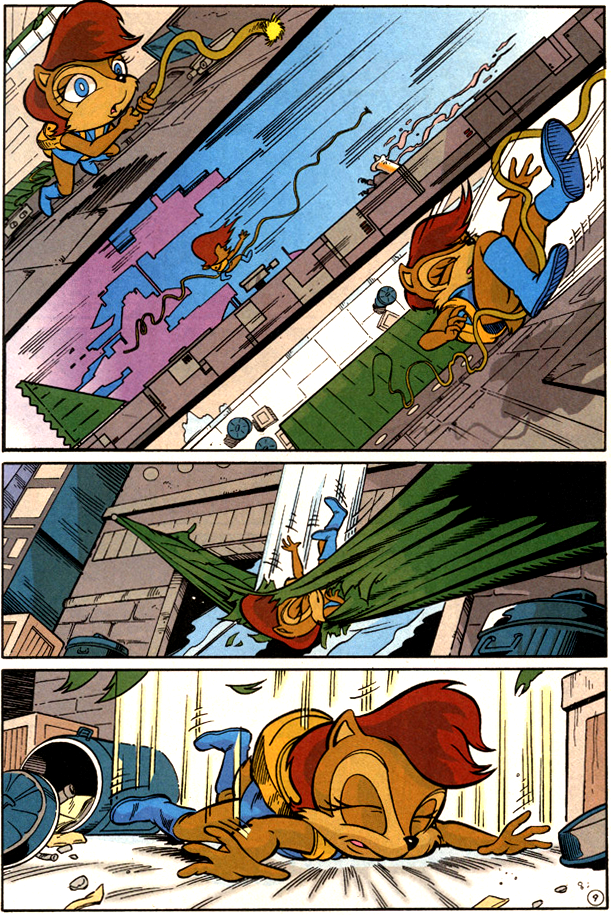
In Ken?s words? ?Main reason I wanted to kill off Princess Sally back in the day: felt she made Sonic into a second banana and cramped his style.?
So you killed her????
Due to immediate fan backlash (and possibly Sally?s role as one of the mascots for Sega World Sydney), Sega quickly demanded that Ken revive Sally. As such, the story was changed. In Ken?s original plans, the ?Sally? who shows up alive at the end of Sonic #50 wasn?t the real Sally, but another robot doppelganger, as foreshadowed in the following issue. However, this whole subplot was scrapped, and the robot doppelganger was quietly retconned to be the real Sally after all. (This did still mean, though, that Sally, the leader of the Freedom Fighters, was in a coma throughout the climactic mission where Robotnik was finally defeated.)
Things didn?t get better after this point. Oh, no, no, no. We still had King Max to deal with.
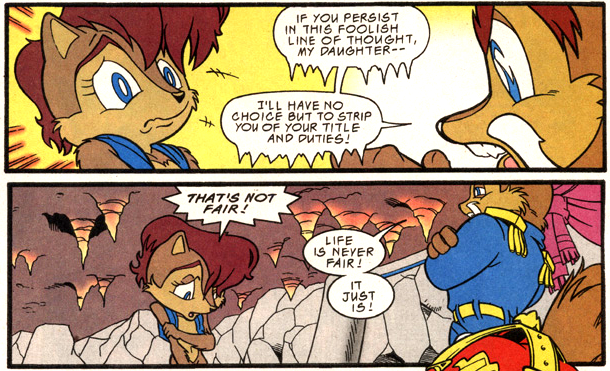
After Robotnik?s death, some of the civilians started to distrust the freed ?Robians? (roboticized Mobians who were formerly Robotnik?s mind controlled slaves), including Sonic?s family. Penders wanted to do a generic oppression allegory for a couple issues. As part of this, one of King Max?s first orders after returning to the throne was to have all of the Robians rounded up and executed. He called for genocide.
Following stories would try to explain that Max wasn?t thinking straight due to the effects of a curse. But even when he was healed, Max was mad at Sally for disobeying his order. You know, his order to commit genocide.
This tension between Sally and her father quickly became a running theme. Sally stomped around the castle complaining about how her dad never told her anything or let her make any decisions of her own, but the cool and rational Max simply told her that father knows best. He was incredibly controlling over her life, forcing her into a loveless political marriage with Antoine at two separate points, and eventually started forbidding her from even leaving the castle. For years, Sally was largely out of the action because her dad said she had to stay home and be the princess. Instead of rebelling, she simply gave up.
Later, in Knuckles #29, Sally heads to Angel Island to ask the Brotherhood for help. Along the way, Penders squeezes in a scene where Sally decides to rationalize her father?s earlier call for robot genocide as ?pragmatic,? and says that she should never have doubted him.

Immediately after this, we got the supremely uncomfortable lead story of the ?Girls Rule? special, lovingly referred to by fans as ?The Sally Dip Story.?
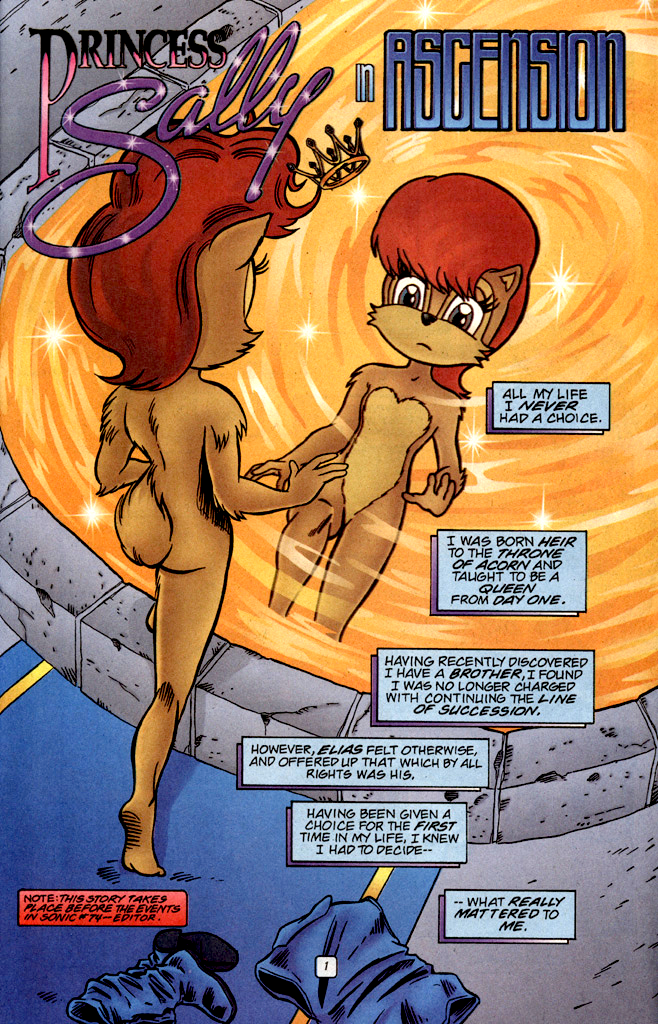
This particular story is infamous for its uncomfortably sexual art by Jim Valentino (reprints would later let Sally keep her vest on), but the story itself is just as nauseating. In it, Sally participates in an ancient (and extremely creepy) rite of passage that all heirs to her family?s throne go through. The ritual involves stripping down and wading into a golden pool of liquid (lovingly referred to by fans as ?the pool of Tang?) so that she can bond with ?the Source of All? ? basically, God. Yes, the Acorn family has their own God separate from the God the echidnas have.
Once bonded with the Source, it begins to communicate with Sally telepathically, sending her a series of visions. And what?s the purpose of these visions? To tell her that her dad can literally see the goddamn future because of his connection to God, and that he is therefore always right.
Yes, the asshole dad who constantly lies to her and manipulates her life is always right! His actions were justified all along! He never has to apologize for anything, because he ?did everything out of love?! Again, between Locke and Max, this is a deeply concerning running theme in Ken?s work. ?Your parents are never wrong, and they only hurt you because they love you.?
Ultimately, this story is framed as an empowering one, simply because Sally decided not to bond with the Source after all. This is somehow framed as an act of agency for her. But even after this, Sally has little agency or personality. Nor do most of the other female characters in his stories.
The rest of the ?Girls Rule? special, Ken?s tribute to the female fans, doesn?t treat the other girls much better. Minor recurring character Lupe the Wolf gets a story where she?s roboticized and then seemingly sacrifices her life to save her family. The story literally ends on a shot of her grave. In Ken?s own words: ?Frankly, I thought the Lupe story was important simply because it showed that even a female could make the ultimate sacrifice on behalf of those dear to her. More often than not, it?s the girls who are usually shown being rescued instead of heroic, and that?s why I felt that this was an opportunity to really make a statement with this character.?
Yeah, you sure did make a statement there, my guy.
Furry racism
I already covered the dingoes, but that actually wasn?t the only instance of echidna colonialism in the comics. When it came time to adapt Sonic Adventure, Ken decided to add an extra subplot. He said that the Mystic Ruins were located in ?Mysterious Cat Country,? a nation in Mobius?s equivalent of South America that the Knuckles Clan colonized. The cats don?t trust the echidnas because of this.
But once again, the victims of the echidnas? colonization are painted as evil. This time, instead of being Nazis, the cats are cannibalistic jungle dwellers who eat their young. They?re much larger and more bestial than the other Mobians, and most of them carry spears. They?re a cruel stereotype in every way possible.
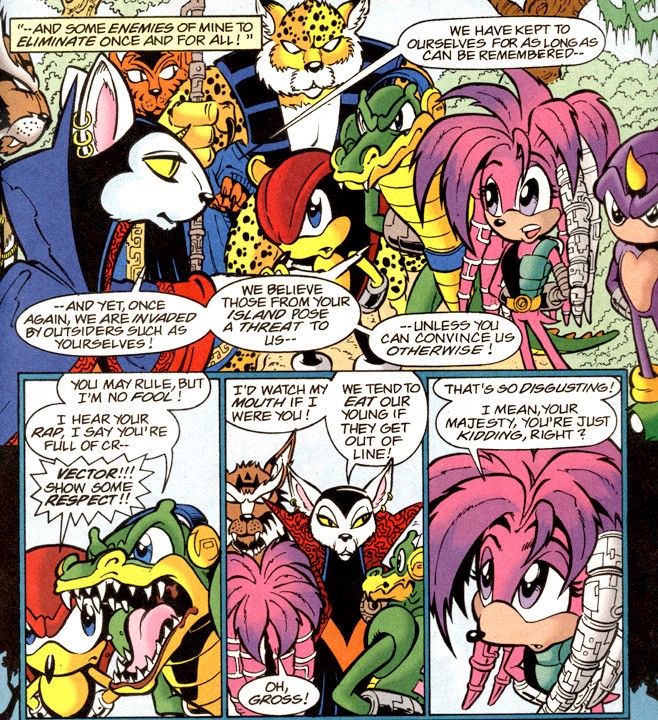
Anyway, so the jungle cats kidnap the Chaotix, and then Locke shows up to beat them up. This is framed as cool and heroic by Penders. This is, of course, an extremely ironic thing to include in what?s otherwise a straight adaptation of Sonic Adventure, a game about breaking cycles of violence through empathy. (Sonic Adventure may not have the deepest writing, but Sonic spells this theme out in the climax.)
Then you have the more? ?urban? characters. In the Knuckles arc where the Chaotix accidentally got high on acid, the villainous drug lord is essentially a stereotypical pimp named Downtown Ebony Hare. The character who took the cake, though, was Vector. In Ken?s stories, Vector was the jive-talking comic relief character. He was obnoxious, he was dim-witted, he was crude, he?d randomly bring up rap music. One time he started singing ?Dem Bones? to himself while held captive by the Dark Legion. He was also extremely misogynistic (one arc literally went into great detail about how he viewed women as prizes to be won ? ironic, given Ken?s treatment of Sally). He constantly said shit that got on the nerves of either Knuckles or Julie-Su, and then they would smack him around to shut him up. It often felt like Penders was turning Vector into Julie-Su?s personal punching bag, making her look ?cooler? and ?tougher? at Vector?s expense.
Anyway, here?s a panel in which I?m almost certain Penders made Vector say ?bee-otch? before someone told him what that meant and it was censored:
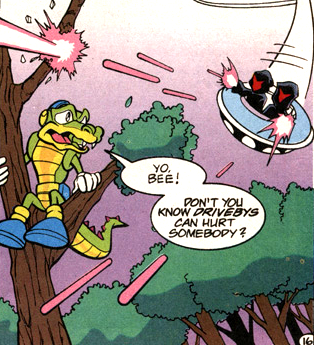
Goddamn fucking love triangles
Romance was always a big aspect of Archie Sonic due to the presence of Sally and the surprisingly large female audience. In most cases, Penders? love stories could be summarized as ?these two characters are in love because I said so.? We rarely saw why any of the couples liked each other. The plot simply dictated it.
The ultimate example of this is Knuckles? relationship with Julie-Su. She literally defects from the Dark Legion, the evil fascist organization that had brainwashed her from birth, because she ?soultouched? with Knuckles. This quite literally means that they?re soulmates from first sight, because this is apparently a function evolution has hard wired into every echidna. Really, Knuckles just needed a girlfriend so that he could have a kid in ?Mobius: 25 Years Later,? so Penders tossed in a new female character and said she was his soulmate.
The comics never really explain how this ?soultouch? process can be so infallible if Locke and Lara-Le ended up getting divorced. There?s also this absurd part where Knuckles straight up asks if he can just be gay instead of dealing with his supposed soulmate, and Locke is like ?now, now son, why don?t we go back to talking about your heterosexuality??
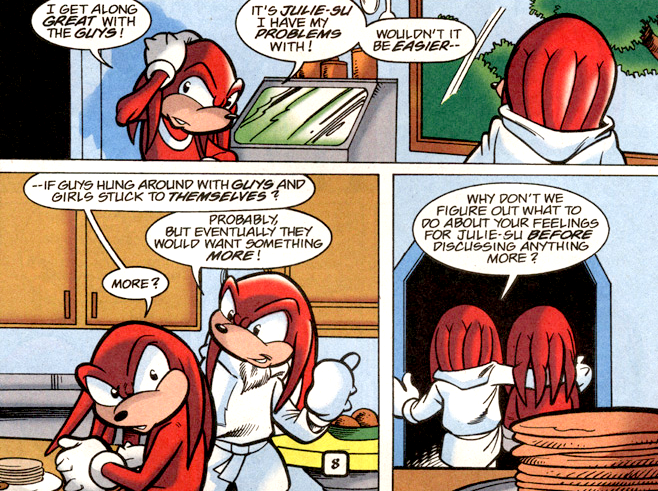
(This issue where Knuckles gets ?the talk? immediately follows the one where Locke tells him he?s a mutant bioweapon.)
There?s also the love triangles. In the first 50 issues of Sonic, Penders focused on one main love triangle between Sonic, Sally, and a new character of his own creation ? Geoffrey St. John. Geoffrey is one of Ken?s most enduring creations, a skunk with an attitude comparable to James Bond and an inconsistent accent. (For years, readers have called Geoffrey his self-insert, but I don?t really feel like that?s the case.)
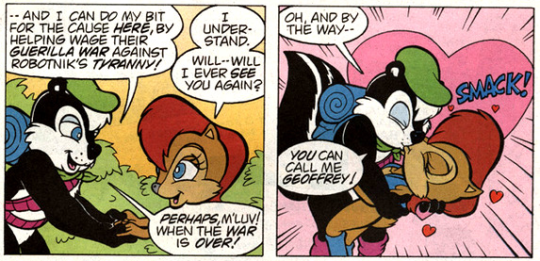
Throughout this era of the comics, Sally would regularly make out with Geoffrey, the older, more suave Freedom Fighter, and Sonic would get angry about this. ?Older?? I can already hear you asking, worried about what that might mean. ?How much older was Geoffrey?? Well, Penders imagined Geoffrey as vaguely ?college aged,? and he was definitely at least 20 or 21 when he was making out with Sally, who at the time was? 15 years old.
Woof.
If that?s not bad enough, Penders got himself into some hot water earlier this year when he ran his mouth on Twitter and declared that during this period of the story, Geoffrey had apparently taken Sally?s virginity off-screen. In his exact words:

Words cannot do justice to how vile this is. Not only because Sally is a minor, but also because of how illuminating it is. It puts that whole arc into perspective. Sally was not an active participant in that love triangle ? she was a prize to be fought over between Sonic and Geoffrey. She had no say, she merely responded to the competing boys? advances. And by being ?faster on the draw,? Geoffrey ?tainted? Sally for Sonic, like how one might lick someone else?s food to keep them from eating it.
(After this initial tweet blew up, Ken dug himself into a very deep hole. His arguments ranged from ?the age of consent on Mobius is actually 16? (Sally wasn?t 16!) to a claim that if Geoffrey hadn?t slept with the underage princess, he would?ve had to turn to ?the kingdom?s red light district.? Apparently he just HAS to fuck.)
But the thing is, that?s only what he thought about doing. No matter what Ken claims, it didn?t make it into the book. But once, in one of the final arcs he wrote? a reference to characters having sex actually made it to print.
Sonic #150 and #151 revolve around Sonic?s evil doppelganger from another universe, Anti-Sonic, posing as the real Sonic and hitting on just about every girl he knows. For the most part, these characters all managed to come out of this relatively unscathed, but one didn?t. And that would just so happen to be my favorite character: poor, poor Bunnie Rabbot.
Tails finds Anti-Sonic making out with Bunnie in the bushes. Now, Bunnie isn?t with her usual boyfriend Antoine at this point, because Antoine had also been replaced with an evil doppelganger at that point, and the evil Antoine broke up with her. But she still had feelings for Antoine, and wanted to win him back. Bunnie is also Sally?s best friend, and she absolutely knew that Sally still had feelings for Sonic at that point. And yet, in spite of this, Bunnie is apparently so desperate to be shown affection that she gladly starts rolling in the hay with ?Sonic.?
After the scene with Tails, we immediately cut to this:
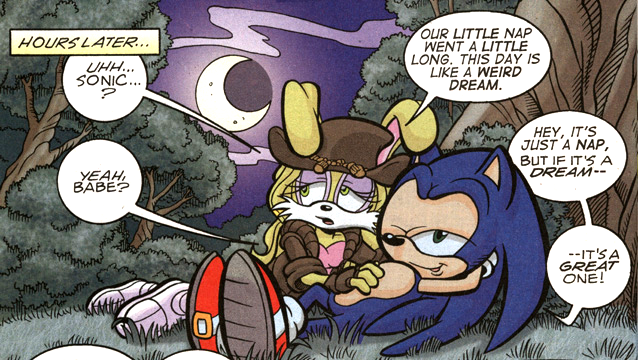
If it?s not obvious, the implication here is that Anti-Sonic tricked Bunnie into having sex with him.
Everything about this is just disgusting, especially Anti-Sonic?s smug wink at the camera. But also, look closer at that dialogue. The lines about a ?nap?? Are in a different font. They aren?t hand lettered. This is a telltale sign that the text was altered late in production. I shudder to think what it originally said. And the icing on the cake? Penders considers this not a story about Bunnie being victimized, but rather a story about her betraying Antoine?s trust by sleeping with another guy.
After this, the real Sonic quickly returns to his rightful place and kicks Anti-Sonic out. Except, he didn?t bother to set the record straight about what happened. In the following issue, Bunnie still had feelings for Sonic, thinking that they had been together. And immediately following this, Sonic inexplicably started dating Fiona Fox as a rebound girlfriend, somehow playing into Ken?s master plan to get Sonic and Sally back together over the next? oh, fifty issues.
Fighting with the other writers over continuity
Thankfully, later writers would fix many of Penders? worst mistakes, including much of the love triangle garbage. In the early 2000s, Karl Bollers completely abandoned Geoffrey?s feelings for Sally and had him marry a woman his age. Much of the first year of Ian Flynn?s run was also dedicated to fixing the quagmire of love triangles that Penders had ended his run on.
Penders was never happy about other writers touching his things, though.
Earlier, I mentioned the ?Return to Angel Island? arc by Karl Bollers. It?s by far my favorite arc in the first 13 years of the series. Set after the comics? big one-year timeskip, the arc has Sonic, Knuckles, Julie-Su, and the Chaotix infiltrating an Eggman-occupied Angel Island to liberate the echidnas.
You see, Echidnaopolis has been reduced to rubble (for real this time), the Brotherhood is missing, and the echidnas are desperate. They no longer have their big fancy city, and they now resemble the Knuckles Tribe from Sonic Adventure. They?ve put all their faith in the Chosen One prophecy surrounding Knuckles, believing that he?ll be the one to save them. Except? Knuckles lost his powers a year ago, and he has no idea if he?s capable of helping. Meanwhile, the ?reformed? Dark Legion is trying to use their advanced technology to fight Eggman and rescue as many people as they can. They really are genuinely helping here? but it?s also clear that they have ulterior motives. Needless to say, the Dark Legion isn?t happy when a powerless Knuckles returns and is immediately hailed as a savior.
Everyone just feels right. Knuckles is finally an underdog, and his fiery personally is on display at long last. The Dark Legion are jerks, but for once their actions make logical sense, and it feels like they actually believe in what they?re doing (even if they?re doing so for the wrong reasons).
Oh, and this arc also introduced Knuckles? baby brother? who Bollers decided to name Kneecaps. Beautiful.
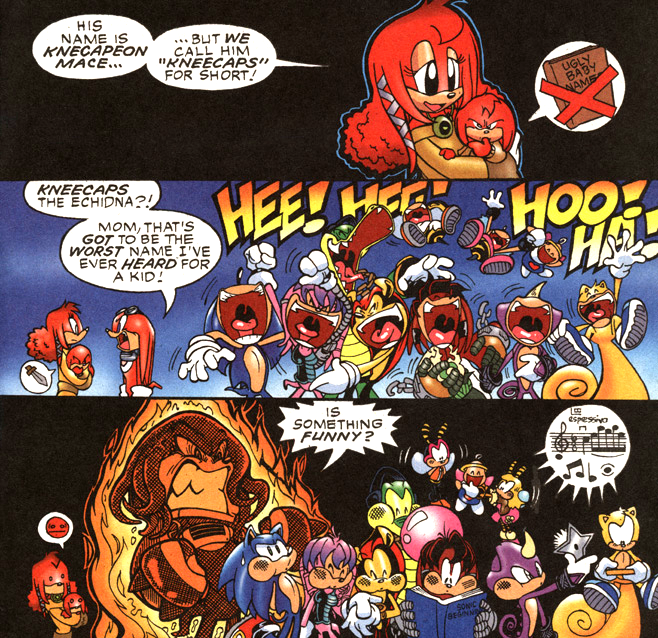
Penders hated this arc, though.
Ken liked to maintain a very specific status quo on Angel Island, and was livid when Karl shook things up. Ken referred to the arc as a ?hissy fit? written to undermine his work. When Karl moved on to other projects and Ken regained control of Angel Island, the echidnas rapidly rebuilt their city, and Locke immediately began searching for the missing Brotherhood. He was determined to erase Karl?s story from relevance and return everything to the way it used to be.
Penders wanted full control over the lore. He was the first writer who gave a shit about the lore in the comics, so in his eyes, his take on the franchise is one of the most important. He sees himself as Sonic?s Jack Kirby ? a visionary creator who was treated unfairly by his employers and not given his due credit. He rants about how Sega and IDW should hire him back so he can completely throw out all of the stories written by Ian Flynn since his departure and get back to what the fans really want.
After all, it was all going somewhere, right?
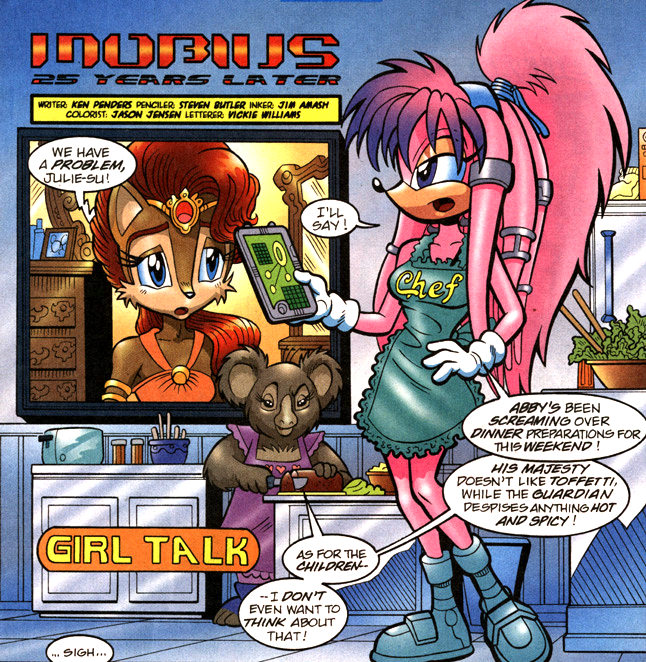
?Mobius: 25 Years Later? ? a story about nothing
The story he was building to ? one of his proudest creative achievements, the story he came back to write after nearly quitting the series with Sonic #125 ? was ?Mobius: 25 Years Later,? published from Sonic #131-#144. This is basically the Boruto or Harry Potter and the Cursed Child of Archie Sonic. It?s the future, and all the characters have been arbitrarily paired off into loveless straight marriages so that they can all have boring kids. Knuckles and Julie-Su are married with a daughter, Lara-Su. King Sonic and Queen Sally have kids. Everyone?s married with kids. Knuckles now sits in a cave all day and monitors Angel Island via his spy cameras, like Locke. It?s all depressing.
While Archie naturally said that M25YL was only one possible future timeline, Ken always intended for it to be the canonical future for these characters, the one he had been foreshadowing from the start. He always hated it when anyone contradicted him on this, too ? legend has it that he banned Karl Bollers from his personal forum over one such argument. He also took any stories that seemingly contradicted the future depicted in M25YL as attempts to undermine him.
What?s the actual plot of this arc, though? Well, towards the beginning, Sonic?s pal Rotor Walrus discovers that Mobius is going to explode. Sonic apparently messed up the timespace continuum something fierce when they were teenagers, and now they?re boned. ?If only we could travel back in time,? Rotor says. But apparently, that?s impossible. I want you to remember that for later.
After this, the story shifts focus almost exclusively to domestic life. They talk about how Lara-Su (the alleged protagonist of the arc) is doing in school, and she begs her dad to make her the next Guardian. They sit around their big fucking mansion, and talk to their creepy looking and vaguely racist koala maid about what they?re going to have for dinner. They have a dinner party. They have a pool party. They have a slumber party. They gossip about the kids? love lives. Julie-Su has a casual Skype video call with Lien-Da, her fascist half-sister who murdered her parents and spent years brainwashing her. For years, Ken assured fans that the future Julie-Su would not be reduced to Knuckles? housewife. But that?s exactly what we got. Even Sonic is boring now. He?s given in to the mundane life of a king, no longer going on adventures. He doesn?t even talk to Tails anymore.
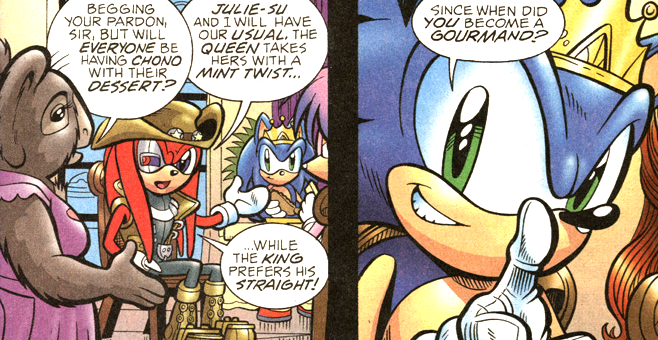
This lasts for about ten issues.
Oh, and then there?s Rotor. Rotor is hanging around this old echidna scientist named Cobar now. He?s just another character to have around so that Rotor isn?t talking to himself when he gives exposition. Nothing really special. No real obvious connection there.
According to Penders, this is Rotor?s husband.
Now, if there?s one thing anyone knows about me, it?s that I am an extremely bisexual woman, and I want every cartoon in the universe to be the gayest and transest shit imaginable. The Sonic comics are no exception. Sally and Nicole for life, babey. But Ken?s attempt at writing Rotor as gay could not have been weaker. It?s all the mildest subtext possible, with no real passion. Sure, gay narratives are often censored, and you can only get away with so much. But Rotor and Cobar barely even seem to be friends. And yet, Ken expects to be heaped with praise for doing the bare minimum. He has literally claimed that his mild hinting at Rotor?s sexuality ?paved the way for Kevin Keller,? Archie?s first openly gay character.
Do you wanna know why we even know about this gay subtext in the first place? Because when Ian Flynn killed off Cobar, thinking that he was a redundant character who added nothing to the story, Ken decided to make a big stink online about how Ian had apparently killed off Rotor?s husband. No one at Archie knew that this was his intention. He never told them.
Upon closer inspection, fans also found one more hint at Penders? plans for Rotor?s sexuality. In a throwaway scene in Sonic #157, Eggman calls Rotor ?our dear Rotor.? Sonic interprets this as meaning that Eggman knows something secret about Rotor. Apparently, this was foreshadowing the fact that Eggman was later going to out Rotor, or just straight up blackmail him.
Gay rights!
?Mobius: 25 Years Later,? while not the final arc Penders wrote for the series, was very clearly the final arc he gave a shit about. And it?s really the perfect encapsulation of his work on the series. It?s got it all! Boring echidna politics, cliffhangers that go nowhere, Knuckles threatening to spank his teenage daughter, everyone inexplicably being chill with the fascist Dark Legion for no reason, Knuckles being the most important person in the world, and female characters getting the shaft.
After about ten issues in which nothing happens, Ken decides to wrap things up. Sonic and Knuckles suddenly start talking about how they oughtta stop the planet from exploding. (Sally isn?t involved with this plan, in spite of being the queen of the most powerful nation in the world, because she?s a woman, and Penders is a misogynist.) So they go talk to Rotor, who suddenly has a brilliant idea?
?What if we went back in time??
And so, the arc ends on a cliffhanger. Ken had several more years of M25YL stories planned, but he never got to write them himself, as he quit the series after Sonic #159.
Thanks to Archie losing their lawsuit against Ken, though, he?s now the proud owner of all of the stories and characters he wrote for Archie. Julie-Su, Geoffrey St. John, Sleuth Doggy Dawg, all his. They?d lost his contract, you see, and therefore the rights defaulted back to him. For the better part of a decade now, Ken has been talking about how he?s finally going to conclude the story of both ?Mobius: 25 Years Later? and the whole Knuckles saga in the form of his new graphic novel series, The Lara-Su Chronicles.
The art looks like this.

Thank you for reading this incredibly long piece that got way out of hand! If you?re new to Thanks Ken Penders and you enjoyed it, maybe give the Tumblr a follow to see my future coverage of Ian Flynn?s run at Archie Sonic. You could also throw me a couple bucks on Ko-Fi, or check out the demo for my upcoming video game, Super Lesbian Animal RPG. Wait, is it considered uncouth to plug yourself at the end of a Medium article? I don?t fuckin? know.
EDIT: If you would like to read something more positive about Archie Sonic, you can read a quick followup article about 10 stories I actually liked (mostly from the other writers). I was also invited by New York Magazine to write an article detailing Ken?s copyright battles and their impact on the Sonic franchise, which you can read here.
